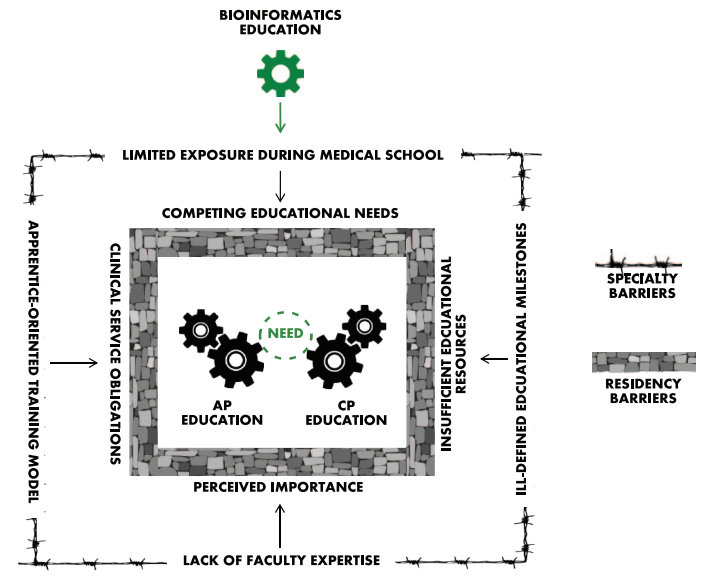Difference between revisions of "Template:Article of the week"
Shawndouglas (talk | contribs) (Updated article of the week text.) |
Shawndouglas (talk | contribs) (Updated article of the week text.) |
||
| Line 1: | Line 1: | ||
<div style="float: left; margin: 0.5em 0.9em 0.4em 0em;">[[File:Fig1 | <div style="float: left; margin: 0.5em 0.9em 0.4em 0em;">[[File:Fig1 Clay CancerInformatics2017 16.png|240px]]</div> | ||
'''"[[Journal: | '''"[[Journal:Bioinformatics education in pathology training: Current scope and future direction|Bioinformatics education in pathology training: Current scope and future direction]]"''' | ||
Training [[Anatomical pathology|anatomic]] and [[clinical pathology]] residents in the principles of [[bioinformatics]] is a challenging endeavor. Most residents receive little to no formal exposure to bioinformatics during medical education, and most of the pathology training is spent interpreting [[histopathology]] slides using light microscopy or focused on laboratory regulation, management, and interpretation of discrete [[laboratory]] data. At a minimum, residents should be familiar with data structure, data pipelines, data manipulation, and data regulations within [[Clinical laboratory|clinical laboratories]]. Fellowship-level training should incorporate advanced principles unique to each subspecialty. Barriers to bioinformatics education include the clinical apprenticeship training model, ill-defined educational milestones, inadequate faculty expertise, and limited exposure during medical training. Online educational resources, case-based learning, and incorporation into molecular genomics education could serve as effective educational strategies. Overall, pathology bioinformatics training can be incorporated into pathology resident curricula, provided there is motivation to incorporate institutional support, educational resources, and adequate faculty expertise. ('''[[Journal:Bioinformatics education in pathology training: Current scope and future direction|Full article...]]''')<br /> | |||
<br /> | <br /> | ||
''Recently featured'': | ''Recently featured'': | ||
: ▪ [[Journal:FluxCTTX: A LIMS-based tool for management and analysis of cytotoxicity assays data|FluxCTTX: A LIMS-based tool for management and analysis of cytotoxicity assays data]] | |||
: ▪ [[Journal:Bioinformatics: Indispensable, yet hidden in plain sight|Bioinformatics: Indispensable, yet hidden in plain sight]] | : ▪ [[Journal:Bioinformatics: Indispensable, yet hidden in plain sight|Bioinformatics: Indispensable, yet hidden in plain sight]] | ||
: ▪ [[Journal:Electronic lab notebooks: Can they replace paper|Electronic lab notebooks: Can they replace paper?]] | : ▪ [[Journal:Electronic lab notebooks: Can they replace paper|Electronic lab notebooks: Can they replace paper?]] | ||
Revision as of 16:24, 2 October 2017
"Bioinformatics education in pathology training: Current scope and future direction"
Training anatomic and clinical pathology residents in the principles of bioinformatics is a challenging endeavor. Most residents receive little to no formal exposure to bioinformatics during medical education, and most of the pathology training is spent interpreting histopathology slides using light microscopy or focused on laboratory regulation, management, and interpretation of discrete laboratory data. At a minimum, residents should be familiar with data structure, data pipelines, data manipulation, and data regulations within clinical laboratories. Fellowship-level training should incorporate advanced principles unique to each subspecialty. Barriers to bioinformatics education include the clinical apprenticeship training model, ill-defined educational milestones, inadequate faculty expertise, and limited exposure during medical training. Online educational resources, case-based learning, and incorporation into molecular genomics education could serve as effective educational strategies. Overall, pathology bioinformatics training can be incorporated into pathology resident curricula, provided there is motivation to incorporate institutional support, educational resources, and adequate faculty expertise. (Full article...)
Recently featured:










